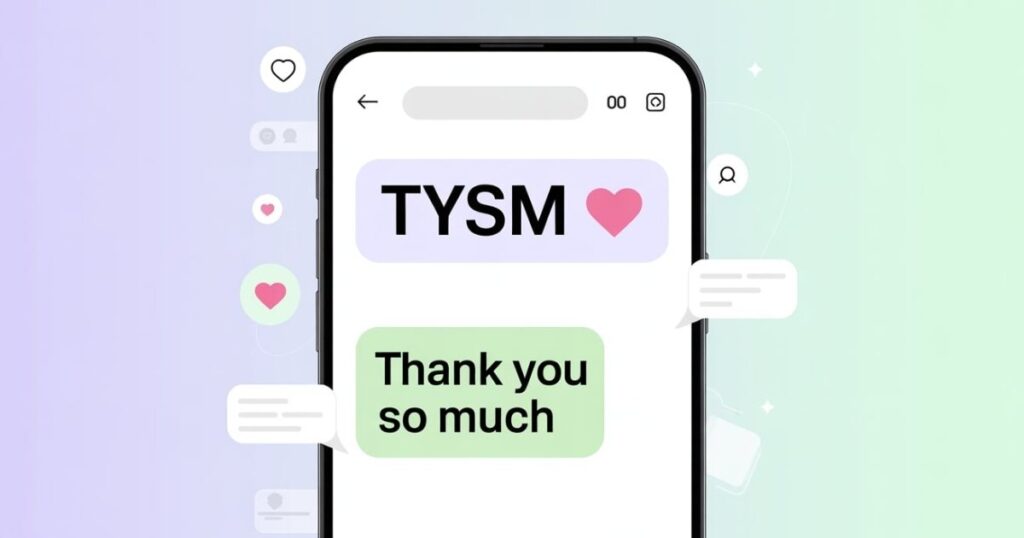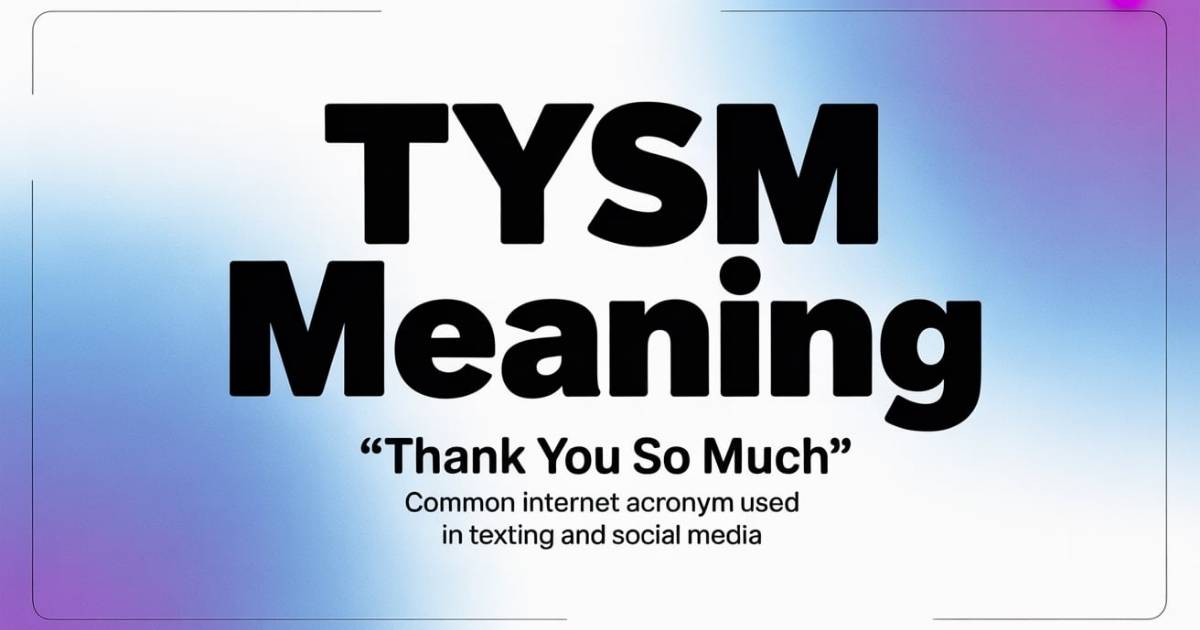Ever got a text that says “TYSM” and wondered what it actually means? You’re scrolling through Instagram, reply to someone’s comment, and boom—they hit you with TYSM. Or maybe you’re chatting on WhatsApp and your friend drops it casually.
TYSM stands for “Thank You So Much.” It’s a quick way people show gratitude in texting, social media, and everyday online communication.
But here’s the thing—just because everyone uses it doesn’t mean you should throw it around everywhere. Sometimes TYSM feels genuine. Other times it sounds robotic, lazy, or even out of place. In 2025, digital language trends are shifting fast. People want authenticity, not just internet shorthand that feels copy-pasted.
This guide breaks down everything about TYSM meaning, when to use it, when to skip it, and 11 better ways to say thank you that actually sound like you mean it.
What Does TYSM Mean?

TYSM is short for “Thank You So Much.” It’s one of the most popular texting abbreviations used across platforms like Instagram, TikTok, Snapchat, and WhatsApp.
People use it to express gratitude quickly without typing out the full phrase. Think of it as a warmer version of just saying “TY” (Thank You).
TYSM adds extra emotion—it shows you’re not just grateful, you’re really grateful. You’ll see it in comments, DMs, group chats, and even emails (though that’s a whole different story we’ll get to).
The full form is simple: Thank You So Much. But the meaning behind it changes depending on who’s saying it, how they’re saying it, and where they’re saying it.
Hiatus Meaning of TYSM Meaning
Here’s where it gets interesting. “Hiatus” usually means a break or pause in something. When we talk about the hiatus meaning of TYSM, we’re digging into how this phrase loses its emotional punch when overused.
TYSM has become so common in modern internet slang 2025 that people type it without thinking.
- It’s automatic.
- It’s reflexive.
- And honestly? It can feel empty.
When you say TYSM to everyone for everything, the sincerity takes a hiatus. The gratitude becomes background noise.
Here’s what happens:
- Shallow emotion – Typing it out of habit, not feeling.
- Context confusion – Using it in the wrong setting makes it awkward.
- Sincerity vs speed – Sometimes a longer, thoughtful message beats a quick acronym.
This doesn’t mean TYSM is bad. It just means you need to be intentional about when and how you use it. Real gratitude shouldn’t be on autopilot.
Is TYSM Polite?
Yes, TYSM is polite—but only in the right situations. It works great with friends, followers, online communities, and casual conversations. But drop it in the wrong place, and you’ll sound unprofessional or too relaxed.
Here’s a quick guide:
✅ Use TYSM with:
- Friends and family
- Social media replies
- Casual DMs
- Online communities
- Relaxed work chats
✖️ Skip TYSM in:
- Formal business emails
- Job interviews
- Client communications
- Academic settings
- Serious professional exchanges
Examples:
✅ “TYSM for the birthday wishes! You made my day 💕”
❌ “TYSM for considering my application.” (Too casual—use “Thank you very much for considering my application.”)
The rule is simple: match your tone to your audience. If you wouldn’t say it face-to-face in that setting, don’t type it either.
Also Read: ICL Meaning: Understanding the Acronym and Its Usage
TYSM in Texting and Social Media
TYSM thrives in digital expressions of gratitude across platforms.
You’ll find it everywhere:
- Instagram comments – “Your art is fire! 🔥” → “TYSM! That means everything 💖”
- TikTok replies – People thanking creators for helpful content.
- WhatsApp chats – Quick gratitude in group messages.
- Snapchat – Casual back-and-forth with friends.
- Reddit threads – Thanking users for advice or help.
It’s fast, friendly, and fits the vibe of casual gratitude expressions. People often pair TYSM with emojis like 🙏, 💖, or 🥹 to add warmth. But remember—popularity doesn’t equal appropriateness. Just because it’s trending doesn’t mean it’s right for every situation.
Example conversation:
- Friend: “I grabbed your coffee order on my way!”
- You: “TYSM! You’re the best 🙌”
This works because the setting is casual, the relationship is close, and the tone matches.
Tone and Nuance: Why It Matters
Different moments call for different thank-you phrases. TYSM might nail it in one situation and totally miss in another. The secret? Understanding tone and context.
Let’s break it down:
Friendly tone – TYSM works perfectly.
- Example: “TYSM for tagging me in that meme!”
Emotional tone – TYSM can work if you add context.
- Example: “TYSM, I’m seriously crying right now 🥺”
Professional tone – Skip TYSM entirely.
- Better option: “I truly appreciate your time and feedback.”
Formal tone – Definitely avoid TYSM.
- Better option: “Thank you for your generous support.”
Here’s a simple chart:
| Setting | TYSM Works? | Better Alternative |
| Friend’s text | ✅ Yes | Still good |
| Emotional moment | ✅ With context | “I can’t thank you enough” |
| Work email | ❌ No | “I appreciate your help” |
| Formal letter | ❌ No | “I’m deeply grateful” |
Bottom line: know your audience and adjust accordingly.
11 Excellent Alternatives to TYSM
Want to sound more genuine and less robotic? Here are 11 polite alternatives to TYSM that work across different situations. Each one brings its own flavor and fits specific tones.
1. Thank You So Much
✅ Best for: General use everywhere—texts, emails, conversations.
💬 Example: “Thank you so much for helping me move last weekend!”
This is the full version of TYSM. It’s clear, warm, and works in almost any setting. Use it when you want to sound sincere without being too formal.
2. I Truly Appreciate It
✅ Best for: Professional thank-you messages and thoughtful replies.
💬 Example: “I truly appreciate your feedback on the project.”
This phrase carries weight. It shows you’re not just saying thanks—you mean it. Perfect for work emails, client interactions, or serious conversations.
3. Thanks a Ton
✅ Best for: Light-hearted, informal thank-you messages with friends.
💬 Example: “Thanks a ton for covering my shift!”
It’s cheerful and casual without sounding fake. Great for everyday situations where you want to keep things friendly.
4. Many Thanks
✅ Best for: Semi-formal communication, message etiquette in polite settings.
💬 Example: “Many thanks for your kind invitation.”
This one feels elegant and respectful. Use it in emails, networking messages, or when talking to people you don’t know super well.
5. I’m Grateful
✅ Best for: Deep, heartfelt moments where conversational tone in messages matters.
💬 Example: “I’m grateful for your support during this tough time.”
This phrase has emotional depth. It’s perfect when someone does something meaningful and you want them to know it touched you.
6. Thank You Kindly
✅ Best for: Soft, respectful tone with a warm touch.
💬 Example: “Thank you kindly for your patience.”
It sounds gentle and thoughtful. Works great in customer service, support messages, or when someone’s been understanding with you.
7. Much Appreciated
✅ Best for: Quick, business-friendly replies that stay professional.
💬 Example: “Got the files—much appreciated!”
It’s short and efficient but still polite. Perfect for work chats, team messages, or when you need to acknowledge something fast.
8. Thanks a Bunch
✅ Best for: Playful, upbeat messages with a fun vibe.
💬 Example: “Thanks a bunch for the surprise gift!”
This one’s light and cheerful. Use it with friends, in casual settings, or anytime you want to sound happy and grateful.
9. I Can’t Thank You Enough
✅ Best for: Moments of deep gratitude when someone goes above and beyond.
💬 Example: “I can’t thank you enough for everything you’ve done.”
This phrase shows someone their help really mattered. It’s powerful and sincere—use it when words almost aren’t enough.
10. Cheers (UK / Friendly tone)
✅ Best for: British-style gratitude or friendly, casual conversations.
💬 Example: “Cheers for the ride home!”
It’s laid-back and friendly. Common in the UK but used globally now in relaxed settings with friends or teammates.
11. Appreciate It / Appreciate You
✅ Best for: Modern, casual American slang-style replies.
💬 Example: “Appreciate you being there for me.”
It’s cool, short, and sounds genuine. Works in close relationships, casual work environments, or when you want to keep it real.
How to Choose the Right Thank-You Expression
Not sure which phrase to pick? Here’s a simple system that takes the guesswork out.
Ask yourself three questions:
1. Who am I talking to?
- Friend, boss, client, stranger, family?
- Your relationship determines your tone.
2. How formal is the situation?
- Text, email, letter, face-to-face?
- Match your words to the setting.
3. What emotion do I want to show?
- Polite, warm, funny, sincere, professional?
- Your feeling should guide your choice.
Real examples:
- Scenario: Your coworker helped with a tight deadline.
- Best choice: “I truly appreciate it” or “Much appreciated.”
- Why it works: Professional but warm—perfect for work relationships.
- Scenario: Your best friend remembered your favorite snack.
- Best choice: “TYSM!” or “Thanks a bunch 💕”
- Why it works: Casual and fun—matches the friendship vibe.
- Scenario: Someone gave you career advice that changed your path.
- Best choice: “I can’t thank you enough” or “I’m grateful.”
- Why it works: Shows depth and sincerity for a meaningful gesture.
Use your gut feeling combined with these questions. You’ll sound natural every time.
Final Thoughts
TYSM is powerful when used right—but it’s not a one-size-fits-all solution. In 2025, online communication is all about authenticity.
People can tell when your gratitude feels real versus when it’s just typed on autopilot. Don’t let TYSM become a habit that loses its meaning.
Save it for moments where it actually fits. And when you need something deeper, warmer, or more professional? Use one of the 11 alternatives we covered.
Gratitude isn’t just about speed—it’s about connection. The right words at the right time can strengthen relationships, build trust, and show people you actually care.
So next time you want to say thanks, pause for a second. Think about who you’re talking to and what you want them to feel. Then choose words that match. Your messages will sound better, feel more genuine, and leave a lasting impression.
Now it’s your turn—which alternative will you try first?

